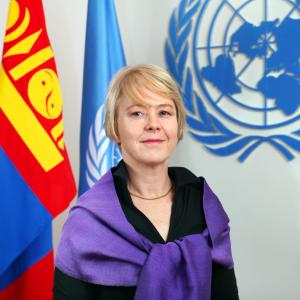Mr BADRAL, Major General, Head of National Emergency Management Agency
Ms YANJINSUREN Sodnomdorj, Adviser to Deputy Prime Minister of Mongolia
Ladies and Gentlemen,
Welcome to UN House,
We are excited to cohost this workshop on Strengthening the Capacity of National and Local Disaster Risk Reduction Councils. The aim is to help those who mitigate and manage disasters in Mongolia be as effective as possible, in their life-saving work.
As one of the most vulnerable countries to climate change on earth, this could not be more crucial in Mongolia. Over the last 70 years, its temperatures have risen by 2.2 degree centigrade, already above the threshold that the rest of the world is trying to avoid. As a result, we are seeing not only hotter summers, but also harsher winters here, giving rise to growing droughts and dzuds. So, our capacity to combat them, must rise too.
The need to reduce risk, build resilience and realize sustainable development has never been more urgent. At no point in human history have we faced such a wide range of risks, in such an inter-connected and fast-changing world. Decades-old projections about climate change have come true much sooner than expected. With these unprecedented environmental shifts, climate-linked disasters are becoming more frequent, more intense and more widespread. This calls for urgent, collective efforts to reduce risk in more innovative ways.
As a result, the world is also seeing a major shift in DRR governance: from preparedness and response TO prevention and risk management. DRR governance is also evolving, from a sole ministry or agency-centric approach, to a whole-of-government and whole-of-society approach.
Every community must be ready to fight and recover from disasters, including by preserving and restoring basic infrastructure and services, to protect development gains. The Sustainable Development Goals call for ending poverty, reducing inequality and ensuring our planet can support future generations. And resilience is fundamental to realizing that agenda. Without it, achievements in human development – such as lifting people out of poverty and providing access to quality healthcare – may suddenly be wiped out.
The most vulnerable people between disasters are also most vulnerable during them. Poverty raises a community’s exposure to risks, while reducing their ability to recover. According to the Overseas Development Institute, by 2030, 325 million people will be living in countries highly exposed to natural disasters caused by extreme weather. Unless steps are taken now, millions of them could be dragged into poverty.
Climate change and disaster risks must be addressed as one, as development can only be sustainable when it is risk-informed. That’s why the Government of Mongolia’s initiative of establishing a Disaster Risk Reduction Council, at national and local levels, to look at these integrated and interlinked matters together is critical.
A key next step to a safer future is to start applying the Sendai indicators. This means completing readiness reviews, setting up baselines and national disaster loss databases. Much progress on these has been made on these here, and must be continued, to further support Mongolia’s DRM reforms.
We commend Mongolia for leading the way in this area, as one of the few countries to approve the National Medium-Term Strategy for Implementing the Sendai Framework 2030. The UN stands ready to help Mongolia further develop local DRR strategies and capacities, including strengthening emergency preparedness and response and sustainable environmental management to reduce future disasters. Because only by building resilience and reducing risk can we truly keep the promise of the SDGs and leave no one behind.
Thank you.






